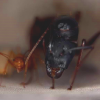Hello, someone proposed me to exchange ants, exotic ants that can be found on Asia for Attas and Camponotus that can be found on Mexico, but the problem is that we would need to send them via international mail. I have searched about sending ants or other animals to other country but I could not find enough information so I would like to know what do you think. Is this guy trying to cheat or should I trust him and give it a shot?
If you think It's not a bad idea then how can we send each other ants that don't belong to our countries? I have seen some ant keepers own ants that don´t belong to their country for example EL MUNDO DE LAS HORMIGAS who is from Spain and owns many such as the Weaver ant, the Bullet ant, the Bulldog ant, Acromyrmex and many others, I don´t know what he does to have those species, can you get special perms or something?
I think this is a complicated theme that needs more attention because I'm sure everyone interested on this hobby would love to get ants from other countries but we don´t want to affect nature transporting species to somewhere they should not live in either.
I would love to hear everyone's point of view, thank you.



















